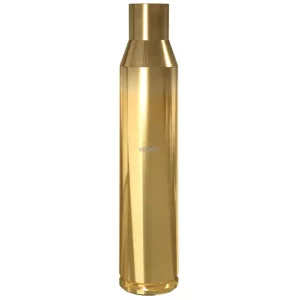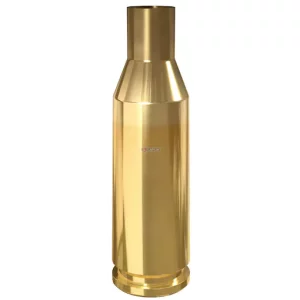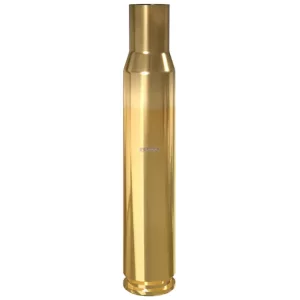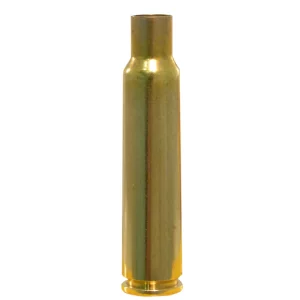Reloading Brass
-
Lapua Brass 338 Norma Magnum Box of 100
Lapua World-class brass begins with high-quality raw materials and superior smelting and metallurgical competence. Throughout the production process, the focus on quality control is consistent with Lapua’s exacting standards. Particular attention is paid to hardness, solidity and grain structure. All Lapua brass is tested to 30% overpressure according to Commission Internationale Permanente, the agency that oversees ammunition and component producers in Western Europe. This is not loaded ammunition.
Brass Preparation: With bulk rifle brass you may sometimes notice a few case mouths are “out of round” or slightly dented below the shoulder. These imperfections occur in the final tumbling wash operation after the case mouth has been annealed. Brass manufacturers are aware of the case cosmetics and have worked to mitigate it, but due to equipment design, denting may still occur. Minor dents are normally removed in the first firing and will not affect case life or performance. On non-plated brass, you may also notice all the anneal stain might not be polished off, which may give the case neck a pinkish color. With some smaller caliber cases you may notice the case mouths to be slightly belled.
With all new rifle brass, you should first straighten out the case and case mouth, then chamfer and debur the case mouth inside and out. To straighten the case mouth, run the case part way into the sizer die and let the expander ball straighten the brass. To prevent the case neck from stretching, be sure to lubricate the case neck inside the case mouth.
CAD $369.00Lapua Brass 338 Norma Magnum Box of 100
CAD $369.00 -
Lapua Brass 6.5x47mm Lapua Box of 100
Lapua World-class brass begins with high-quality raw materials and superior smelting and metallurgical competence. Throughout the production process, the focus on quality control is consistent with Lapua’s exacting standards. Particular attention is paid to hardness, solidity and grain structure. All Lapua brass is tested to 30% overpressure according to Commission Internationale Permanente, the agency that oversees ammunition and component producers in Western Europe. This is not loaded ammunition.
Brass Preparation: With bulk rifle brass you may sometimes notice a few case mouths are “out of round” or slightly dented below the shoulder. These imperfections occur in the final tumbling wash operation after the case mouth has been annealed. Brass manufacturers are aware of the case cosmetics and have worked to mitigate it, but due to equipment design, denting may still occur. Minor dents are normally removed in the first firing and will not affect case life or performance. On non-plated brass, you may also notice all the anneal stain might not be polished off, which may give the case neck a pinkish color. With some smaller caliber cases you may notice the case mouths to be slightly belled.
With all new rifle brass, you should first straighten out the case and case mouth, then chamfer and debur the case mouth inside and out. To straighten the case mouth, run the case part way into the sizer die and let the expander ball straighten the brass. To prevent the case neck from stretching, be sure to lubricate the case neck inside the case mouth.
CAD $159.00Lapua Brass 6.5x47mm Lapua Box of 100
CAD $159.00 -
Lapua Brass 6.5mm-284 Norma Box of 100
Lapua World-class brass begins with high-quality raw materials and superior smelting and metallurgical competence. Throughout the production process, the focus on quality control is consistent with Lapua’s exacting standards. Particular attention is paid to hardness, solidity and grain structure. All Lapua brass is tested to 30% overpressure according to Commission Internationale Permanente, the agency that oversees ammunition and component producers in Western Europe. This is not loaded ammunition.
Brass Preparation: With bulk rifle brass you may sometimes notice a few case mouths are “out of round” or slightly dented below the shoulder. These imperfections occur in the final tumbling wash operation after the case mouth has been annealed. Brass manufacturers are aware of the case cosmetics and have worked to mitigate it, but due to equipment design, denting may still occur. Minor dents are normally removed in the first firing and will not affect case life or performance. On non-plated brass, you may also notice all the anneal stain might not be polished off, which may give the case neck a pinkish color. With some smaller caliber cases you may notice the case mouths to be slightly belled.
With all new rifle brass, you should first straighten out the case and case mouth, then chamfer and debur the case mouth inside and out. To straighten the case mouth, run the case part way into the sizer die and let the expander ball straighten the brass. To prevent the case neck from stretching, be sure to lubricate the case neck inside the case mouth.
CAD $179.00Lapua Brass 6.5mm-284 Norma Box of 100
CAD $179.00 -
Lapua Brass 338 Lapua Magnum Box of 100
Lapua World-class brass begins with high-quality raw materials and superior smelting and metallurgical competence. Throughout the production process, the focus on quality control is consistent with Lapua’s exacting standards. Particular attention is paid to hardness, solidity and grain structure. All Lapua brass is tested to 30% overpressure according to Commission Internationale Permanente, the agency that oversees ammunition and component producers in Western Europe. This is not loaded ammunition.
Brass Preparation: With bulk rifle brass you may sometimes notice a few case mouths are “out of round” or slightly dented below the shoulder. These imperfections occur in the final tumbling wash operation after the case mouth has been annealed. Brass manufacturers are aware of the case cosmetics and have worked to mitigate it, but due to equipment design, denting may still occur. Minor dents are normally removed in the first firing and will not affect case life or performance. On non-plated brass, you may also notice all the anneal stain might not be polished off, which may give the case neck a pinkish color. With some smaller caliber cases you may notice the case mouths to be slightly belled.
With all new rifle brass, you should first straighten out the case and case mouth, then chamfer and debur the case mouth inside and out. To straighten the case mouth, run the case part way into the sizer die and let the expander ball straighten the brass. To prevent the case neck from stretching, be sure to lubricate the case neck inside the case mouth.
CAD $369.00Lapua Brass 338 Lapua Magnum Box of 100
CAD $369.00 -
Lapua Brass 284 Winchester Box of 100
Lapua World-class brass begins with high-quality raw materials and superior smelting and metallurgical competence. Throughout the production process, the focus on quality control is consistent with Lapua’s exacting standards. Particular attention is paid to hardness, solidity and grain structure. All Lapua brass is tested to 30% overpressure according to Commission Internationale Permanente, the agency that oversees ammunition and component producers in Western Europe. This is not loaded ammunition.
Brass Preparation: With bulk rifle brass you may sometimes notice a few case mouths are “out of round” or slightly dented below the shoulder. These imperfections occur in the final tumbling wash operation after the case mouth has been annealed. Brass manufacturers are aware of the case cosmetics and have worked to mitigate it, but due to equipment design, denting may still occur. Minor dents are normally removed in the first firing and will not affect case life or performance. On non-plated brass, you may also notice all the anneal stain might not be polished off, which may give the case neck a pinkish color. With some smaller caliber cases you may notice the case mouths to be slightly belled.
With all new rifle brass, you should first straighten out the case and case mouth, then chamfer and debur the case mouth inside and out. To straighten the case mouth, run the case part way into the sizer die and let the expander ball straighten the brass. To prevent the case neck from stretching, be sure to lubricate the case neck inside the case mouth.
CAD $189.00Lapua Brass 284 Winchester Box of 100
CAD $189.00 -
Lapua Brass 300 PRC Box of 100
Lapua World-class brass begins with high-quality raw materials and superior smelting and metallurgical competence. Throughout the production process, the focus on quality control is consistent with Lapua’s exacting standards. Particular attention is paid to hardness, solidity and grain structure. All Lapua brass is tested to 30% overpressure according to Commission Internationale Permanente, the agency that oversees ammunition and component producers in Western Europe. This is not loaded ammunition.
Brass Preparation: With bulk rifle brass you may sometimes notice a few case mouths are “out of round” or slightly dented below the shoulder. These imperfections occur in the final tumbling wash operation after the case mouth has been annealed. Brass manufacturers are aware of the case cosmetics and have worked to mitigate it, but due to equipment design, denting may still occur. Minor dents are normally removed in the first firing and will not affect case life or performance. On non-plated brass, you may also notice all the anneal stain might not be polished off, which may give the case neck a pinkish color. With some smaller caliber cases you may notice the case mouths to be slightly belled.
With all new rifle brass, you should first straighten out the case and case mouth, then chamfer and debur the case mouth inside and out. To straighten the case mouth, run the case part way into the sizer die and let the expander ball straighten the brass. To prevent the case neck from stretching, be sure to lubricate the case neck inside the case mouth.
CAD $209.00Lapua Brass 300 PRC Box of 100
CAD $209.00 -
Lapua Brass 220 Russian Box of 100
Lapua World-class brass begins with high-quality raw materials and superior smelting and metallurgical competence. Throughout the production process, the focus on quality control is consistent with Lapua’s exacting standards. Particular attention is paid to hardness, solidity and grain structure. All Lapua brass is tested to 30% overpressure according to Commission Internationale Permanente, the agency that oversees ammunition and component producers in Western Europe. This is not loaded ammunition.
Brass Preparation: With bulk rifle brass you may sometimes notice a few case mouths are “out of round” or slightly dented below the shoulder. These imperfections occur in the final tumbling wash operation after the case mouth has been annealed. Brass manufacturers are aware of the case cosmetics and have worked to mitigate it, but due to equipment design, denting may still occur. Minor dents are normally removed in the first firing and will not affect case life or performance. On non-plated brass, you may also notice all the anneal stain might not be polished off, which may give the case neck a pinkish color. With some smaller caliber cases you may notice the case mouths to be slightly belled.
With all new rifle brass, you should first straighten out the case and case mouth, then chamfer and debur the case mouth inside and out. To straighten the case mouth, run the case part way into the sizer die and let the expander ball straighten the brass. To prevent the case neck from stretching, be sure to lubricate the case neck inside the case mouth.
CAD $149.00Lapua Brass 220 Russian Box of 100
CAD $149.00 -
Lapua Brass 243 Winchester
Lapua World-class brass begins with high-quality raw materials and superior smelting and metallurgical competence. Throughout the production process, the focus on quality control is consistent with Lapua’s exacting standards. Particular attention is paid to hardness, solidity and grain structure. All Lapua brass is tested to 30% overpressure according to Commission Internationale Permanente, the agency that oversees ammunition and component producers in Western Europe. This is not loaded ammunition.
Brass Preparation: With bulk rifle brass you may sometimes notice a few case mouths are “out of round” or slightly dented below the shoulder. These imperfections occur in the final tumbling wash operation after the case mouth has been annealed. Brass manufacturers are aware of the case cosmetics and have worked to mitigate it, but due to equipment design, denting may still occur. Minor dents are normally removed in the first firing and will not affect case life or performance. On non-plated brass, you may also notice all the anneal stain might not be polished off, which may give the case neck a pinkish color. With some smaller caliber cases you may notice the case mouths to be slightly belled.
With all new rifle brass, you should first straighten out the case and case mouth, then chamfer and debur the case mouth inside and out. To straighten the case mouth, run the case part way into the sizer die and let the expander ball straighten the brass. To prevent the case neck from stretching, be sure to lubricate the case neck inside the case mouth.
CAD $144.00Lapua Brass 243 Winchester
CAD $144.00 -
Lapua Brass 6.5 Creedmoor
Lapua World-class brass begins with high-quality raw materials and superior smelting and metallurgical competence. Throughout the production process, the focus on quality control is consistent with Lapua’s exacting standards. Particular attention is paid to hardness, solidity and grain structure. All Lapua brass is tested to 30% overpressure according to Commission Internationale Permanente, the agency that oversees ammunition and component producers in Western Europe. This is not loaded ammunition.
Brass Preparation: With bulk rifle brass you may sometimes notice a few case mouths are “out of round” or slightly dented below the shoulder. These imperfections occur in the final tumbling wash operation after the case mouth has been annealed. Brass manufacturers are aware of the case cosmetics and have worked to mitigate it, but due to equipment design, denting may still occur. Minor dents are normally removed in the first firing and will not affect case life or performance. On non-plated brass, you may also notice all the anneal stain might not be polished off, which may give the case neck a pinkish color. With some smaller caliber cases you may notice the case mouths to be slightly belled.
With all new rifle brass, you should first straighten out the case and case mouth, then chamfer and debur the case mouth inside and out. To straighten the case mouth, run the case part way into the sizer die and let the expander ball straighten the brass. To prevent the case neck from stretching, be sure to lubricate the case neck inside the case mouth.
CAD $129.00Lapua Brass 6.5 Creedmoor
CAD $129.00 -
Lapua Brass 30-06 Springfield Box of 100
Lapua World-class brass begins with high-quality raw materials and superior smelting and metallurgical competence. Throughout the production process, the focus on quality control is consistent with Lapua’s exacting standards. Particular attention is paid to hardness, solidity and grain structure. All Lapua brass is tested to 30% overpressure according to Commission Internationale Permanente, the agency that oversees ammunition and component producers in Western Europe. This is not loaded ammunition.
Brass Preparation: With bulk rifle brass you may sometimes notice a few case mouths are “out of round” or slightly dented below the shoulder. These imperfections occur in the final tumbling wash operation after the case mouth has been annealed. Brass manufacturers are aware of the case cosmetics and have worked to mitigate it, but due to equipment design, denting may still occur. Minor dents are normally removed in the first firing and will not affect case life or performance. On non-plated brass, you may also notice all the anneal stain might not be polished off, which may give the case neck a pinkish color. With some smaller caliber cases you may notice the case mouths to be slightly belled.
With all new rifle brass, you should first straighten out the case and case mouth, then chamfer and debur the case mouth inside and out. To straighten the case mouth, run the case part way into the sizer die and let the expander ball straighten the brass. To prevent the case neck from stretching, be sure to lubricate the case neck inside the case mouth.
CAD $129.00Lapua Brass 30-06 Springfield Box of 100
CAD $129.00 -
Norma Brass Shooters Pack 7.5mm Schmidt-Rubin (7.5x55mm Swiss) Box of 50
Norma Shooter’s Pack brass is packaged by Norma in convenient quantities. Norma USA Brass is world renowned as being the absolute highest quality brass available. These cases start off with the best possible raw materials with the narrowest tolerances. The case necks are annealed to soften the brass and prevent gas leaks the case body is at the optimum hardness to avoid any unnecessary stretching. New, unprimed brass that features chamfered and deburred case mouths and a punched flash hole (magnum calibers are drilled). These cases should be sized before loading. This is not loaded ammunition.
Brass Preparation: With bulk rifle brass you may sometimes notice a few case mouths are “out of round” or slightly dented below the shoulder. These imperfections occur in the final tumbling wash operation after the case mouth has been annealed. Brass manufacturers are aware of the case cosmetics and have worked to mitigate it, but due to equipment design, denting may still occur. Minor dents are normally removed in the first firing and will not affect case life or performance. On non-plated brass, you may also notice all the anneal stain might not be polished off, which may give the case neck a pinkish color. With some smaller caliber cases you may notice the case mouths to be slightly belled.
With all new rifle brass, you should first straighten out the case and case mouth, then chamfer and debur the case mouth inside and out. To straighten the case mouth, run the case part way into the sizer die and let the expander ball straighten the brass. To prevent the case neck from stretching, be sure to lubricate the case neck inside the case mouth.
CAD $71.00 -
Norma Brass Shooters Pack 416 Remington Magnum Box of 50
Norma Shooter’s Pack brass is packaged by Norma in convenient quantities. Norma USA Brass is world renowned as being the absolute highest quality brass available. These cases start off with the best possible raw materials with the narrowest tolerances. The case necks are annealed to soften the brass and prevent gas leaks the case body is at the optimum hardness to avoid any unnecessary stretching. New, unprimed brass that features chamfered and deburred case mouths and a punched flash hole (magnum calibers are drilled). These cases should be sized before loading. This is not loaded ammunition.
Brass Preparation: With bulk rifle brass you may sometimes notice a few case mouths are “out of round” or slightly dented below the shoulder. These imperfections occur in the final tumbling wash operation after the case mouth has been annealed. Brass manufacturers are aware of the case cosmetics and have worked to mitigate it, but due to equipment design, denting may still occur. Minor dents are normally removed in the first firing and will not affect case life or performance. On non-plated brass, you may also notice all the anneal stain might not be polished off, which may give the case neck a pinkish color. With some smaller caliber cases you may notice the case mouths to be slightly belled.
With all new rifle brass, you should first straighten out the case and case mouth, then chamfer and debur the case mouth inside and out. To straighten the case mouth, run the case part way into the sizer die and let the expander ball straighten the brass. To prevent the case neck from stretching, be sure to lubricate the case neck inside the case mouth.
CAD $121.00












